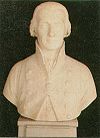
José Manuel de Ezpeleta
Encyclopedia

Cuba
The Republic of Cuba is an island nation in the Caribbean. The nation of Cuba consists of the main island of Cuba, the Isla de la Juventud, and several archipelagos. Havana is the largest city in Cuba and the country's capital. Santiago de Cuba is the second largest city...
from 1785 to 1789, and viceroy of New Granada
New Kingdom of Granada
The New Kingdom of Granada was the name given to a group of 16th century Spanish colonial provinces in northern South America governed by the president of the Audiencia of Bogotá, an area corresponding mainly to modern day Colombia and parts of Venezuela. Originally part of the Viceroyalty of...
from 1789 to 1797.
A knight of the Order of Charles III and of the Royal and Military Order of San Hermenegildo
Royal and Military Order of San Hermenegildo
The Royal and Military Order of Saint Hermenegild is both a general military honor and a legion created by Fernando VII of Spain dating from 1814....
, he was also a judge of the Order of St. John. He was a governor of the Supreme Royal Council to His Majesty and a councilor of state, as well as field marshal in the royal army.
On December 1, 1785 he became Spanish governor of Cuba. He held this position until 1789, when he was promoted to viceroy of New Granada.
As viceroy of New Granada
His term of office saw the birth of journalism in New Granada, under the direction of Manuel del Socorro Rodríguez, the first director of Papel Periódico in Bogotá. Two hundred sixty-five issues of this periodical appeared.Ezpeleta founded the first theater in Bogotá. He supported literary circles, in which some of the future heroes of the independence movement participated. In 1794, Antonio Nariño
Antonio Nariño
Antonio de la Santísima Concepción Nariño y Álvarez was an ideological Colombian precursor and one of the early political and military leaders of the independence movement in the New Granada - Early political activity :Nariño was born to an aristocratic family...
published a translation of the Rights of Man
Rights of Man
Rights of Man , a book by Thomas Paine, posits that popular political revolution is permissible when a government does not safeguard its people, their natural rights, and their national interests. Using these points as a base it defends the French Revolution against Edmund Burke's attack in...
, for which he was tried and convicted.
Like his predecessors, Ezpeleta tried to spur the mining industry in Mariquita, but he came to the conclusion that the operating expenses were greater than the output. He promoted Catholic missions as a means of pacifying the Indigenous who had not accepted Spanish rule, especially those of Andaquies.

